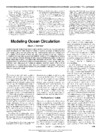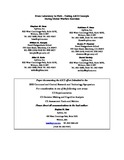Modeling Ocean Circulation
| dc.contributor.author | Semtner, Albert | |
| dc.date.accessioned | 2018-04-19T21:14:35Z | |
| dc.date.available | 2018-04-19T21:14:35Z | |
| dc.date.issued | 1995-09-08 | |
| dc.identifier.uri | https://hdl.handle.net/10945/57961 | |
| dc.description | The article of record as published may be found at http://dx.doi.org/10.1126/science.269.5229.1379 | |
| dc.description.abstract | Ocean numerical models have become quite realistic over the past several years as a result of improved methods, faster computers, and global data sets. Models now treat basin-scale to global domains while retaining the fine spatial scales that are important for modeling the transport of heat, salt, and other properties over vast distances. Simulations are reproducing observed satellite results on the energetics of strong currents and are properly showing diverse aspects of thermodynamic and dynamic ocean responses ranging from deep-water production to EI Niño. Now models can represent not only currents but also the consequences for climate, biology, and geochemistry over time spans of months to decades. However, much remains to be understood from models about ocean circulation on longer time scales, including the evolution of the dominant water masses, the predictability of climate, and the ocean's influence on global change. | en_US |
| dc.format.extent | 8 p. | |
| dc.rights | This publication is a work of the U.S. Government as defined in Title 17, United States Code, Section 101. Copyright protection is not available for this work in the United States. | |
| dc.title | Modeling Ocean Circulation | en_US |
| dc.type | Article | |
| dc.contributor.corporate | Naval Postgraduate School (U.S.) | |
| dc.contributor.department | Oceanography | en_US |





